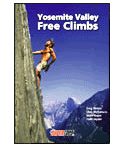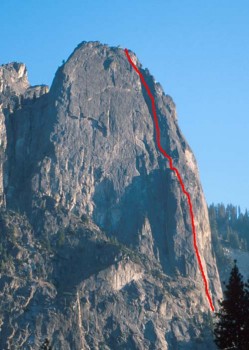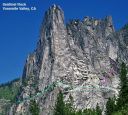Steck Salathe, Sentinel Rock 5.9 |
||
Yosemite Valley, California USA | ||
| ||
|
Avg time to climb route: 8-10 hours
Approach time: 1-1.5 hours Descent time: 1.5-2 hours Number of pitches: 16 Height of route: 1500' Overview
The Steck-Salathe is a route with a reputation as a "hard 5.9." It consists of sustained physical climbing, off-widths, chimneys and awkward climbing. This climb requires most parties a long day to complete. The protection is good for all crux section and the quality of the route is stellar. The temperatures are comfortable even in summer because the route ascends chimneys that provide shade in the afternoon. Spectacular views from the route and especially from the top of The Sentinel provide a glorious reward for completion of a worthy route.
Photos
- View all 20 photos of Steck Salathe as: Thumbnails | Slideshow
Climber Beta on Steck Salathe
Which SuperTopo guidebooks include a topo for Steck Salathe?
Find other routes like
Steck Salathe
History
Even in the infancy of Valley climbing, Sentinel Rock beckoned. Its northern escarpment, especially at sunset, glistened with cracks and dihedrals, some perhaps climbable. Pioneers of the 1930s ventured up the lower, tree-covered part of the formation, returning humbled by the nightmare above: a 1,500-foot wall of tremendous steepness and disconnected crack systems.Yet after the Lost Arrow Chimney climb of 1947, the upper north wall of Sentinel became the "next great problem," and the route was never in question: head for the top of a prominent buttress (soon named the Flying Buttress) and enter the Great Chimney, which led to the top. In 1948 Robin Hansen, Fritz Lippmann, and Jack Arnold made the first attempt—and quit after 100 feet. Jim Wilson and Phil Bettler were next, a year later: they got one pitch higher. Wilson and Bettler soon returned with two of the most competent climbers of the day, Allen Steck and Bill Long, but this team turned back after two days and 450 feet. Long and Bettler came back in May 1950, reaching the halfway point, the top of the Flying Buttress. They retreated. Four attempts, four retreats. Steck had watched the last bid with great interest, and was not unhappy with the outcome. “I lay awake many a night in Berkeley,” he later wrote, “wondering what this north wall was like above the buttress; it was almost an obsession with me.” Steck was no stranger to difficult climbing. In 1949 he had become the first American to climb one of the fabled “Six Great North Faces” of the Alps when he did the Cima Grande in the Dolomites. In late June 1950, Steck asked the renowned John Salathé to try the wall with him and the 51-year-old Swiss instantly agreed. The pair reached the top of the Flying Buttress late on Day Two. Ahead lay new ground: the Headwall. Salathé labored for more than ten hours on this pitch, placing six bolts and many marginal pitons. Finally, the two men were able to work across a slab and enter the Great Chimney, the gateway to the summit. Meanwhile, the pair had to deal with an even more malevolent enemy: the heat. The wall became a furnace. Steck acutely remembers their thirst: “Standing there in slings, with his hammer poised over the star drill, John would turn his head and say, ‘Al, if I only could have just a little... GET Yosemite Valley Free Climbs and read the rest this history and much more. Strategy
Get a dawn start (or earlier), as the combination of the approach, climb, and descent is demanding.” Bring plenty of food and water as well as a headlamp and jacket. The route receives a limited amount of sun in the afternoon keeping the temperatures cool even during mid-summer. A 60m rope is not mandatory but allows doing the route in as few as 10 pitches.The first crux is the Wilson Overhang, which seems to keep getting harder due to rockfall. The second and most feared crux is The Narrows. Here you must climb a spooky squeeze chimney inside the rock or climb even harder terrain outside. Make sure your squeeze chimney technique is dialed before attempting this pitch. Retreat
Retreat from this route can be accomplished with two 50m ropes. There are usually fixed rappel anchors to use for the entire route except on Pitch 10. With only one rope (50m or 60m), you will be required to leave gear to retreat. The route follows a major watercourse and will become potentially dangerous during rain. If you are forced to bivy, there are a number of good ledges on which to be relatively comfortable.Approach
This 1.5-mile-long approach gains about 1,500 feet in elevation. Park at the paved pullouts for the Four Mile Trail (1.8 miles from El Cap Meadow) and hike up the trail about 0.5 mile to a creek crossing (dry in late season). Just before the creek crossing, leave the trail and hike up the talus slope. Cairns mark the trail as it switchbacks up the talus. At a point near the base of the rock, the trail splits; hike up and right toward the large ramp. Continue up this ramp and slightly right until you reach a trail contouring west (right). This trail traverses a ledge and passes trees to another ramp leading up and right. Continue several hundred feet up the talus... GET Yosemite Valley Free Climbs and read the rest this approach as well beta for over 200 other classic Yosemite routes.Descent
From the top of Sentinel Rock, hike north and east following a trail through the bushes and over boulders into the gully. Continue down and eastward through the gully, being careful of loose rock. Once down the gully, cross a creek and continue over slabs down and right. Scramble down the slabs past bushes and trees. Once at the base of the slabs, hike along the right side of the trees and down a bit (with more slabs on the right). Cut left through the trees and contour over to the point where the approach trail splits. Follow the trail back down the talus to the Four Mile Trail and return to the trailhead.Everything You Need to Know About
Yosemite Valley
Search the internet for beta on
Steck Salathe
Links to related internet pages with info on Steck Salathe
Other guidebooks that include info on Steck Salathe
|
Other Routes on Sentinel Rock
|









